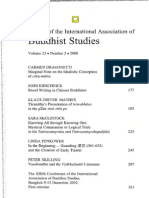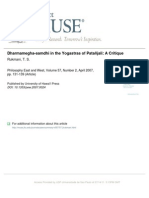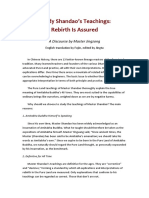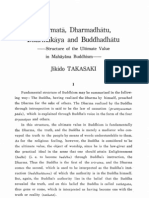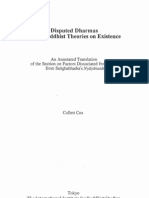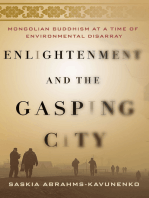0 ratings0% found this document useful (0 votes)
368 viewsWalser Akutobhaya Trans
Walser Akutobhaya Trans
Uploaded by
josephwalserThe document discusses the beginning of movement or going. It states that prior to the commencement of movement, there exists neither what is currently being traversed, what has already been traversed, nor where the movement should begin. It questions how movement can occur in something that has not yet been traversed. The document also notes that the concepts of what has been traversed, what has not yet been traversed, and what is currently being traversed, which are all connected to movement, are not evident at the start of movement.
Copyright:
Attribution Non-Commercial (BY-NC)
Available Formats
Download as PDF, TXT or read online from Scribd
Walser Akutobhaya Trans
Walser Akutobhaya Trans
Uploaded by
josephwalser0 ratings0% found this document useful (0 votes)
368 views23 pagesThe document discusses the beginning of movement or going. It states that prior to the commencement of movement, there exists neither what is currently being traversed, what has already been traversed, nor where the movement should begin. It questions how movement can occur in something that has not yet been traversed. The document also notes that the concepts of what has been traversed, what has not yet been traversed, and what is currently being traversed, which are all connected to movement, are not evident at the start of movement.
Copyright
© Attribution Non-Commercial (BY-NC)
Available Formats
PDF, TXT or read online from Scribd
Share this document
Did you find this document useful?
Is this content inappropriate?
The document discusses the beginning of movement or going. It states that prior to the commencement of movement, there exists neither what is currently being traversed, what has already been traversed, nor where the movement should begin. It questions how movement can occur in something that has not yet been traversed. The document also notes that the concepts of what has been traversed, what has not yet been traversed, and what is currently being traversed, which are all connected to movement, are not evident at the start of movement.
Copyright:
Attribution Non-Commercial (BY-NC)
Available Formats
Download as PDF, TXT or read online from Scribd
Download as pdf or txt
0 ratings0% found this document useful (0 votes)
368 views23 pagesWalser Akutobhaya Trans
Walser Akutobhaya Trans
Uploaded by
josephwalserThe document discusses the beginning of movement or going. It states that prior to the commencement of movement, there exists neither what is currently being traversed, what has already been traversed, nor where the movement should begin. It questions how movement can occur in something that has not yet been traversed. The document also notes that the concepts of what has been traversed, what has not yet been traversed, and what is currently being traversed, which are all connected to movement, are not evident at the start of movement.
Copyright:
Attribution Non-Commercial (BY-NC)
Available Formats
Download as PDF, TXT or read online from Scribd
Download as pdf or txt
You are on page 1of 23
327
how can it begin to gO?30
Alternately:
13. Prior to the commence.ent of going, there
exists neither what is being traversed nor
"hat has been traversed nor where going
should begin. How will it occur in what has
not yet been traversed?
3
1
1". It is thought, how is there what has been
traversed? How is there what has not yet been
traversed? How is there what is being
traversed? All (of these which are) connected
to going are not evident in (their)
commence.ent.
32
[Commentary: ]
30 Sanskrit "gate narabhyate (cf. De Jong, 371 narabhyate
'gatel narabhyate gamyamane gantumarabhyate kuhal I"
31 Sanskrit (Poussin) "(na gamanarambhad na va
yatrarabhyeta gamanam agate Poussin's mss. read."agasti
gamanarambhat" for the first pada. Since this did not make he
suggests Rna in keeping with the sense of the passage. However,
Akira Saito's work with some additional manuscripts has allowed him to
correct the first pada to be prag astiR. His explanation is as
follows:"_TD 250, 251, 252, MBB-I, -II agasti; R. gasti. Agasti is most
probably due to the misreading of the letter pra as a. 'Prior to the
commencement of going, there exists neither what is being gone over
(gamyamana) nor what has been gone over (gata)'" Saito, Akira.
"Textcritical Remarks on the Mulamadhyamakakarika as cited in the
Prasannapada." Journal of Indian and Buddhist Studies, 33 (2 1985): 844.
I have adopted his reading.
32 Sanskrit vikalpyatel
arambhe gamanasyaiva sarvathal I"
You might also like
- p000 - 000 Acta Asiatica 118 - 2 ZimmermannDocument15 pagesp000 - 000 Acta Asiatica 118 - 2 ZimmermannMichael ZimmermannNo ratings yet
- Jaini, Padmanabh, Śrama As Their Conflict With Brāhma Ical Society PDFDocument52 pagesJaini, Padmanabh, Śrama As Their Conflict With Brāhma Ical Society PDFNubiaSCNo ratings yet
- Life of VasubandhuDocument28 pagesLife of Vasubandhukala01100% (1)
- Early Works and Persons Related To The So-Called Jñānapāda SchoolDocument25 pagesEarly Works and Persons Related To The So-Called Jñānapāda SchoolStefanNo ratings yet
- Vyakhyayukti 9178 9469 1 SMDocument55 pagesVyakhyayukti 9178 9469 1 SMLy Bui100% (1)
- Shankara - A Hindu Revivalist or A Crypto-Buddhist PDFDocument71 pagesShankara - A Hindu Revivalist or A Crypto-Buddhist PDFPrasad NeerajNo ratings yet
- Abhidharmakośabhā Ya (Treasury of Metaphysics With Self-Commentary)Document16 pagesAbhidharmakośabhā Ya (Treasury of Metaphysics With Self-Commentary)wintwarNo ratings yet
- Alikakaravada RatnakarasantiDocument20 pagesAlikakaravada RatnakarasantiChungwhan SungNo ratings yet
- Review Patañjali's Vyākaraṇa-Mahābhāṣya. Samarthāhnika (P 2.1.1) by S. D. Joshi PatañjaliDocument3 pagesReview Patañjali's Vyākaraṇa-Mahābhāṣya. Samarthāhnika (P 2.1.1) by S. D. Joshi PatañjaliMishtak BNo ratings yet
- Review of U.T. Kragh Ed. The FoundationDocument6 pagesReview of U.T. Kragh Ed. The FoundationShim JaekwanNo ratings yet
- Sphota Doctrine in Sanskrit Semantics Demystified by Joshi N.R.Document16 pagesSphota Doctrine in Sanskrit Semantics Demystified by Joshi N.R.PolisettyNo ratings yet
- Michael Pye, Skilful Means: A Concept in Mahayana BuddhismDocument27 pagesMichael Pye, Skilful Means: A Concept in Mahayana BuddhismadikarmikaNo ratings yet
- Kellner Taber 2014 Yogacara Idealism IDocument48 pagesKellner Taber 2014 Yogacara Idealism Irob100% (1)
- Tibet. Volume Two: Assimilation Into Indigenous Scholarship (HandbuchDocument5 pagesTibet. Volume Two: Assimilation Into Indigenous Scholarship (Handbuchyogeshwithraj505No ratings yet
- Tzohar, Roy - Imagine Being A PretaDocument18 pagesTzohar, Roy - Imagine Being A PretaroytzoNo ratings yet
- Metre, Mantra and Madhyamaka: Aspects of The Buddhist In-Tellectual Culture of VikramaśīlaDocument3 pagesMetre, Mantra and Madhyamaka: Aspects of The Buddhist In-Tellectual Culture of VikramaśīlaHevajraNo ratings yet
- Kunda Bhatta On The Meaning of Sanskrit VerbsDocument39 pagesKunda Bhatta On The Meaning of Sanskrit VerbsAganooru VenkateswaruluNo ratings yet
- Jiabs 28-1Document227 pagesJiabs 28-1JIABSonline100% (1)
- Jikido Takasaki - The Tathagatagarbha Theory in The Mahaparinirvana-Sutra (Paper)Document10 pagesJikido Takasaki - The Tathagatagarbha Theory in The Mahaparinirvana-Sutra (Paper)thewitness3No ratings yet
- Brill's Encyclopedia of Buddhism: LivesDocument8 pagesBrill's Encyclopedia of Buddhism: Lives1011760% (1)
- The Chapter On The Mundane Path (Laukikamarga) in The Sravakabhumi Vol 2Document328 pagesThe Chapter On The Mundane Path (Laukikamarga) in The Sravakabhumi Vol 2Guhyaprajñāmitra3100% (2)
- Dignaga's Work (Potter 2003) ALLDocument62 pagesDignaga's Work (Potter 2003) ALLkhnum02No ratings yet
- M ST Zieba Buddhist Classification of Dharmas Pancavastuka of VasumitraDocument9 pagesM ST Zieba Buddhist Classification of Dharmas Pancavastuka of VasumitranoychoHNo ratings yet
- David Drewes - Revisiting The Phrase 'Sa Prthivīpradeśaś Caityabhūto Bhavet' and The Mahāyāna Cult of The BookDocument43 pagesDavid Drewes - Revisiting The Phrase 'Sa Prthivīpradeśaś Caityabhūto Bhavet' and The Mahāyāna Cult of The BookDhira_No ratings yet
- 9277 9952 1 PB PDFDocument53 pages9277 9952 1 PB PDF张晓亮No ratings yet
- Springer Journal of Indian Philosophy: This Content Downloaded From 5.62.41.138 On Mon, 30 Dec 2019 16:08:58 UTCDocument26 pagesSpringer Journal of Indian Philosophy: This Content Downloaded From 5.62.41.138 On Mon, 30 Dec 2019 16:08:58 UTCMariana CastroNo ratings yet
- A Preliminary Study of The Meaning of Yoga in Sangharaksa's Yogacarabhumi and Its ContextDocument59 pagesA Preliminary Study of The Meaning of Yoga in Sangharaksa's Yogacarabhumi and Its ContextGuhyaprajñāmitra3No ratings yet
- Solomon Onorigins Indian ScriptDocument10 pagesSolomon Onorigins Indian Scriptclaudia_graziano_3No ratings yet
- Ames W - Notion of Svabhava in The Thought of Candrakirti (JIP 82)Document17 pagesAmes W - Notion of Svabhava in The Thought of Candrakirti (JIP 82)UnelaboratedNo ratings yet
- Tzohar Columbia 0054D 10044Document291 pagesTzohar Columbia 0054D 10044gansiqiNo ratings yet
- RUKMANI - Dharmamegha-Samandhi in The Yogastras of PatañajaliDocument10 pagesRUKMANI - Dharmamegha-Samandhi in The Yogastras of PatañajaliNicoSobrievisNo ratings yet
- Bhamati CatussutriDocument647 pagesBhamati CatussutriAshwin Kumble100% (1)
- Jiabs 27-1Document248 pagesJiabs 27-1JIABSonline100% (2)
- Brereton 1986 - Tat Tvam Asi in ContextDocument13 pagesBrereton 1986 - Tat Tvam Asi in ContextalastierNo ratings yet
- The Three TurningsDocument2 pagesThe Three TurningsmgijssenNo ratings yet
- Study Master ShandaoDocument7 pagesStudy Master ShandaoRivka ShareNo ratings yet
- A Study On Scholarly Activities in The Last Period of The Vikramaśīla Monastery - Quotations in Ratnarak Ita's Padminī PDFDocument16 pagesA Study On Scholarly Activities in The Last Period of The Vikramaśīla Monastery - Quotations in Ratnarak Ita's Padminī PDFTimNo ratings yet
- Buddhism - Buddhist Philosophy of Language., Buddhist Semiotics., Buddhism in Semiotics., EpistemeDocument8 pagesBuddhism - Buddhist Philosophy of Language., Buddhist Semiotics., Buddhism in Semiotics., EpistemeMetta-Physics DiscussionsNo ratings yet
- Some Considerations On The Relationship Between Hindu and Buddhist Tantras by Francesco SferraDocument16 pagesSome Considerations On The Relationship Between Hindu and Buddhist Tantras by Francesco SferraJigdrel77No ratings yet
- Buddhist Philosophy of Language in India: Jñanasrimitra on ExclusionFrom EverandBuddhist Philosophy of Language in India: Jñanasrimitra on ExclusionNo ratings yet
- Jiabs 24-2Document171 pagesJiabs 24-2JIABSonline50% (2)
- CH An Foyen Thomas F Cleary TR Instant ZenDocument12 pagesCH An Foyen Thomas F Cleary TR Instant Zenpatsai1989No ratings yet
- 050 Mathes Collections 041-318Document278 pages050 Mathes Collections 041-318Demetrius Barreto TeixeiraNo ratings yet
- Siva Sutra PaperDocument16 pagesSiva Sutra PaperShivaram Reddy ManchireddyNo ratings yet
- (Brill's Indological Library 20) Kevin McGrath - The Sanskrit Hero - Karna in Epic Mahābhārata-Brill Academic Publishers (2004) PDFDocument273 pages(Brill's Indological Library 20) Kevin McGrath - The Sanskrit Hero - Karna in Epic Mahābhārata-Brill Academic Publishers (2004) PDFVyzNo ratings yet
- Bentor 2016 Divergent Perspectives On TH PDFDocument28 pagesBentor 2016 Divergent Perspectives On TH PDFRobert C HoodNo ratings yet
- The Literature of The Personalists of Early Buddhism Chau 1999 PDFDocument254 pagesThe Literature of The Personalists of Early Buddhism Chau 1999 PDFHansang KimNo ratings yet
- Dharmata Dharmadhatu Dharmakaya and Buddhadhatu - Takasaki JDocument17 pagesDharmata Dharmadhatu Dharmakaya and Buddhadhatu - Takasaki JKathodhraNo ratings yet
- Review of Design and Rhetoric in A Sanskrit Court Epic: The "Kirātārjunīya" of Bhāravi, by Indira Viswanathan Peterson.Document5 pagesReview of Design and Rhetoric in A Sanskrit Court Epic: The "Kirātārjunīya" of Bhāravi, by Indira Viswanathan Peterson.Ben WilliamsNo ratings yet
- Lambert Schmithausen - A Note On The Origin of Ahi SāDocument18 pagesLambert Schmithausen - A Note On The Origin of Ahi SāƁuddhisterie2100% (1)
- Witzel - How-To-Enter A Vedic MindDocument16 pagesWitzel - How-To-Enter A Vedic Mindspongebob2812No ratings yet
- Buddhist Epistemology and Research in Buddhist StudiesDocument14 pagesBuddhist Epistemology and Research in Buddhist StudiesMattia SalviniNo ratings yet
- Rethinking Non Self A New Perspective FR PDFDocument21 pagesRethinking Non Self A New Perspective FR PDFCNo ratings yet
- The Buddhist Critique of Sassatavada and UcchedavadaDocument22 pagesThe Buddhist Critique of Sassatavada and Ucchedavadaar15t0tleNo ratings yet
- Cox, Collett - Disputed Dharmas - Early Buddhist Theories On ExistenceDocument480 pagesCox, Collett - Disputed Dharmas - Early Buddhist Theories On ExistenceDR PRABHAT TANDONNo ratings yet
- Norman 1994 Asokan MiscellanyDocument11 pagesNorman 1994 Asokan MiscellanyLinda LeNo ratings yet
- Enlightenment and the Gasping City: Mongolian Buddhism at a Time of Environmental DisarrayFrom EverandEnlightenment and the Gasping City: Mongolian Buddhism at a Time of Environmental DisarrayNo ratings yet




